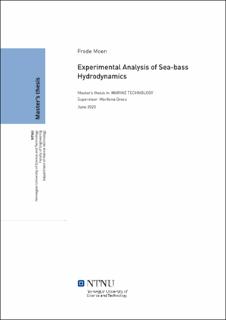| dc.contributor.advisor | Greco, Marilena | |
| dc.contributor.author | Moen, Frode | |
| dc.date.accessioned | 2021-09-21T16:34:31Z | |
| dc.date.available | 2021-09-21T16:34:31Z | |
| dc.date.issued | 2020 | |
| dc.identifier | no.ntnu:inspera:54166542:20963811 | |
| dc.identifier.uri | https://hdl.handle.net/11250/2780155 | |
| dc.description.abstract | I forkant av denne masteroppgaven ble det utført et eksperiment for å analysere hydrodynamikken for det stabile strømningsbildet til en havabbor. Den første delen av dette arbeidet foreslår en analytisk løsning av havabborens svømmeform (dvs. bølgebevegelse) basert på dette eksperimentet. Et litteraturstudie ble utført for å forstå de nødvendige teoretiske prinsippene som hydrodynamikk for fisk og de effektive svømmeferdighetene til en havabbor. Denne oppgaven vil legge fram de to hovedbidragene til svømmebevegelsen, nemlig bølgebevegelse og rekyl. Disse to svømmemekanismene er analysert hver for seg med det formål å utnytte deres styrker for undervannsrobotikk. To sentrale metoder i oppgavens analyse har vært Fast Fourier Transforms (FFT) og Least square-metoden (LSM).
For å analysere fiskebevegelsen under eksperimentet ble et kamera hengt opp i fugleperspektiv over fisken. Problemet med det eksperimentelle oppsettet var imidlertid at kameraet hadde for lav oppløsning, noe som betyr at flere objekter var visuelt forstyrrende for omrisset til fisken. Derfor ble en omfattende bildebehandling utført ved bruk av en foreslått semiautomatisk kode for å redusere denne forstyrrelsen og forbedre den observerte omrisset av fisken. Fordi den identifiserte midtlinjen var for grov, måtte en kurvetilnærming gjennomgjøres for å forutsi en bedre midtlinje. Videre ble frekvensen, amplituden, fasen og bølgetallet funnet for den kombinerte fiskebevegelsen ved bruk av FFT. For å identifisere fiskebevegelsen uten å påvirke midtlinjen ble LSM deretter brukt. Ved å evaluere poeng direkte fra midtlinjen ble det funnet et analytisk uttrykk for både bevegelsen og rekylen. Til slutt ble påvirkningen av veggens tilstedeværelse i eksperimentet evaluert og laget en form-kopi av havabboren. Dette ble implementert ved hjelp av programvaren OpenFOAM.
Etter å ha foreslått metodene beskrevet ovenfor, ble resultater funnet og diskutert. Et interessant funn var at eksperimentet som analysen og resultatene var basert på, viser rom for forbedring. Fisken gjør uventede manøvrer og viser en unaturlig oppførsel som gjør analysen av den stabile svømmeformen utfordrende. En foreslått løsning er å la fisken svømme over lengre tid for å nå et stabil svømmemønster før eksperimentet starter. I tillegg kan andre valg av bakgrunnsfarger og materialer forbedre eksperimentoppsettet.
Den største utfordringen ved å hente ut bevegelsen, var å overvinne de fysiske aspektene ved faseforskyvningen. Til tross for dette var resultatene tilfredsstillende, men en grundigere analyse anbefales for videre arbeid. En annen motivasjon for videre arbeid er å forbedre lineariseringsmetoden for referanseloven til LSM. OpenFOAM har vist seg å være et kraftig rammeverk for å analysere havabborens bevegelse. Den numeriske metoden er avhengig av det valgte “grid”, som kan forbedres ytterligere for å oppnå enda bedre fremtidige resultater. | |
| dc.description.abstract | Prior to this Master thesis, an experiment was conducted to analyse the hydrodynamics involved in steady swimming of a sea bass. The first part of this work propose an analytical solution of the sea bass' swimming form (i.e. locomotion) based on this experiment. A preliminary study was conducted to understand the necessary theoretical principles such as the fish-like hydrodynamics and the efficient swimming characteristics of a sea bass. This thesis will present the two major aspects of the swimming form, namely the locomotion and recoil. These two swimming mechanisms have been analysed separately with the aim of exploiting their strengths in underwater robotics. Two methods that stand out in the relevant analysis have been the Fast Fourier Transforms (FFT) and the Least square method (LSM).
To analyse the fish movement a camera was fixed with a bird's eye perspective above the fish during the experiment. However, the problem with the experimental setup was that the camera had too low resolution meaning that multiple object was visually disturbing with the outline of the fish. Therefore a comprehensive image processing was conducted using a proposed semi automatic code to decrease this disturbance and enhance the detected outline of the fish. The consequence of the identified midline being to rough, was that a curve fitting process had to be done in order to predict a better midline. Furthermore, the frequency, amplitude, phase and wave number was found for the combined fish motion using a Fast Fourier Transform. To identify the fish motion without influencing the midline, the Least Square Method was then used. By evaluating points directly from the midline, an analytical expression for both the locomotion and the recoil was found. Finally, the influence of wall effect in the experiment was evaluated creating a fish foil replica of the sea bass. This was implemented using the software OpenFOAM.
After proposing the methods described above, results were obtained and discussed. One interesting finding was that the experiment of which the analysis and results were based on show room for improvement. The fish makes unexpected maneuvers and show an unnatural behaviour causing the post analysis of the steady swimming form challenging. A proposed solution is allowing the fish to swim for a longer period of time to reach a stable swimming mode before starting the experiment. Additionally, other choice of background colors and materials might improve the experimentation setup.
When extracting the locomotion, the biggest challenge was to overcome the physical aspects of the phase shifts. Despite this, the results were satisfactory, but a more thorough analysis is recommended for further work. Another motivation for further work is to enhance the linearization method for the reference law of the LSM. OpenFOAM has shown to be a powerful framework in analysing the locomotion of the sea bass. The numerical method relies heavily on the chosen grid, which may be further enhanced to obtain even better future results, when imposing the locomotion. | |
| dc.language | | |
| dc.publisher | NTNU | |
| dc.title | Experimental Analysis of Sea-bass Hydrodynamics | |
| dc.type | Master thesis | |
